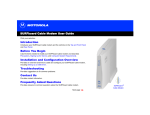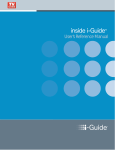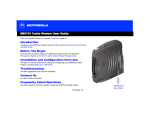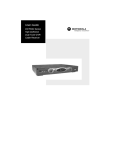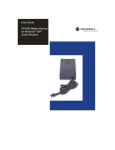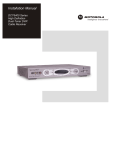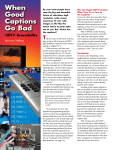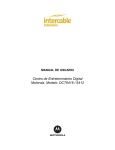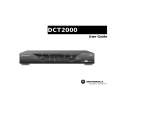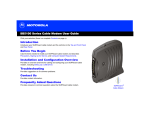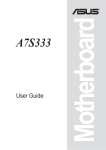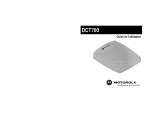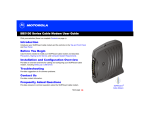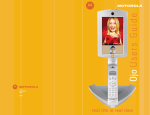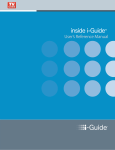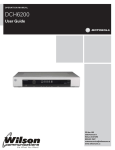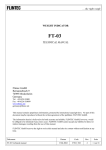Download hd dct 6412/16 dual tuner dvr
Transcript
CAUTION RISK OF ELECTRIC SHOCK CAUTION: TO REDUCE THE RISK OF ELECTRIC SHOCK, DO NOT REMOVE COVER (OR BACK). NO USER-SERVICEABLE PARTS INSIDE. REFER SERVICING TO QUALIFIED SERVICE PERSONNEL. Graphical symbols and supplemental warning marking locations on bottom of terminal. WARNING TO PREVENT FIRE OR SHOCK HAZARD, DO NOT EXPOSE THIS APPLIANCE TO RAIN OR MOISTURE. CAUTION TO PREVENT ELECTRICAL SHOCK, DO NOT USE THIS (POLARIZED) PLUG WITH AN EXTENSION CORD, RECEPTACLE, OR OTHER OUTLET UNLESS THE BLADES CAN BE FULLY INSERTED TO PREVENT BLADE EXPOSURE. The lightning flash with arrowhead symbol, within an equilateral triangle, is intended to alert the user to the presence of uninsulated “dangerous voltage” within the product’s enclosure that may be of sufficient magnitude to constitute a risk of electric shock to persons. The exclamation point, within an equilateral triangle, is intended to alert the user to the presence of important operating and maintenance (servicing) instructions in the literature accompanying the appliance. REPAIRS If you find the unit in need of repair, call Motorola Support at 1-866-668-2271 or 1-866-MOT-BCS1. NOTE TO CATV SYSTEM INSTALLER This reminder is provided to call the CATV system installer’s attention to Article 820-40 of the NEC that provides guidelines for proper grounding and, in particular, specifies that the cable ground shall be connected to the grounding system of the building, as close as possible to the point of cable entry as practical. EXAMPLE OF ANTENNA GROUNDING Electric service Ground equipment clamp Antenna lead in wire Antenna discharge unit (NEC Section 810-20) Grounding clamps Grounding conductors (NEC Section 810-21) Power service grounding electrode system (NEC Article 250, Part H) NEC=NATIONAL ELECTRICAL CODE IMPORTANT SAFETY INSTRUCTIONS 1 Read instructions All the safety and operating instructions should be read before the appliance is operated. 2 Retain instructions The safety and operating instructions should be retained for future reference. 3 Heed warnings All warnings on the appliance and in the operating instructions should be adhered to. 4 Follow instructions All operating and use instructions should be followed. 5 Cleaning Unplug this product from the wall outlet before cleaning. Do not use liquid cleaners or aerosol cleaners. Use a damp cloth for cleaning. 6 Attachments Do not use attachments not recommended as they may cause hazard. 7 Water and moisture Do not use this equipment near water; for example, near a bathtub, wash bowl, kitchen sink, or laundry-tub, in a wet basement, or near a swimming pool, and the like. 8 Accessories Do not place this product on an unstable cart, stand, tripod, bracket, or table. The product may fall causing serious injury and serious damage to the appliance. Use only with a cart, stand, tripod, bracket, or table recommended by the manufacturer, or sold with the equipment. Any mounting of the appliance should follow the manufacturer’s instructions, and should use a mounting accessory recommended by the manufacturer. 9 Ventilation Slots and openings in the cabinet are provided for ventilation and to ensure reliable operation of the equipment and to protect it from overheating. The openings should never be blocked by placing the product on a bed, sofa, rug, or similar surface. Equipment should never be placed near or over a radiator or heat register, or in a built-in installation such as a bookcase or rack unless proper ventilation is provided. 10 Power sources This product should be operated only from the type of power sources indicated on the marking label. If you are not sure of the type of power supplied to your home, consult your local power company. For equipment intended to operate from battery power, or other sources, refer to the operating instructions. 11 Ground or polarization This equipment may be equipped with a polarized alternating-current line plug (a plug having one blade wider than the other). This plug will fit into the power outlet only one way. This is a safety feature. If you are unable to insert the plug fully into the outlet, try reversing the plug. If the plug should still fail to fit, contact your electrician to replace your obsolete outlet. Do not defeat the safety purpose of the polarized plug. 12 Alternate warnings This equipment may be equipped with a 3-wire grounding-type plug, a plug having a third (grounding) pin. This pin will only fit into a grounding-type power outlet. This is a safety feature. If you are unable to insert the plug into the outlet, contact your electrician to replace your obsolete outlet. Do not defeat the safety purpose of the grounding-type plug. 13 Power cord protection Power supply cords should be routed so that they are not likely to be walked on or pinched by items placed upon or against them, paying particular attention to cords at plugs, convenience receptacles, and the point where they exit from the appliance IMPORTANT SAFETY INSTRUCTIONS 14 Outdoor Antenna Grounding If an outside antenna or cable system is connected to the equipment, be sure the antenna or cable system is grounded as to provide some protection against voltage surges and built-up static charges. 15 Lightning For added protection for this equipment during a lightning storm, or when it is left unattended and unused for long periods of time, unplug it from the wall outlet and disconnect the antenna or cable system. This will prevent damage to the video product due to lightning and power line surges. 16 Power lines An outside antenna system should not be located in the vicinity of overhead power lines or where it can fall into such power lines or circuits. When installing an outside antenna system, extreme care should be taken to keep from touching such power lines or circuits, as contact with them may be fatal. 17 Overloading Do not overload wall outlets and extension cords as this can result in a risk of fire or electrical shock. 18 Object and liquid entry Never push objects of any kind into this equipment through openings, as they may touch dangerous voltage points or short-out parts that could result in a fire or electrical shock. Never spill liquid of any kind on the product. 19 Servicing Do not attempt to service this equipment yourself, as opening or removing covers may expose you to dangerous voltage or other hazards, refer all servicing to qualified service personnel. 20 Damage requiring service Unplug this equipment from the wall outlet and refer servicing to qualified service personnel under the following conditions: a When the power supply cord or plug is damaged. b If the equipment has been exposed to rain or water. c If liquid has been spilled, or objects have fallen into the equipment. d If the equipment does not operate normally by following the operating instructions. Adjust only those controls that are covered by the operating instructions, as an improper adjustment of other controls may result in damage and will often require extensive work by a qualified technician to restore the equipment to its normal operation. e If the equipment has been dropped or cabinet has been damaged. f When the equipment exhibits a distinct change in performance, indicating a need for service. 21 Replacement parts When replacement parts are required, be sure the service technician has used replacement parts specified by the manufacturer or have the same characteristics as the original part. Unauthorized substitutions may result in fire, electric shock, or other hazards. 22 Safety check Upon completion of any service or repairs to this video product, ask the service technician to perform safety checks to determine that the product is in proper operational condition. IMPORTANT SAFETY INSTRUCTIONS 23 Battery usage Notwithstanding any information provided by Motorola in this manual regarding the use of batteries, the end user assumes all responsibility and liability to use and dispose of batteries in accordance with all applicable laws, rules and regulations. Motorola will not be liable to anyone for the end user's failure to use and/or dispose of batteries in the proper manner and in accordance with such laws, rules and regulations, or for any defect contained in batteries which may cause injury damage to persons or property. 24 Heat This product should be situated away from heat sources such as radiators, heat registers, stoves, or other products (including amplifiers) that produce heat. Regulatory Information Federal Communications Commission Radio and Television Interface Statement for a Class ‘B’ Device This equipment has been tested and found to comply with the limits for a Class B digital device, pursuant to part 15 of the FCC Rules. These limits are designed to provide reasonable protection against harmful interference in the residential installation. This equipment generates, uses and can radiate radio frequency energy and, if not installed and used in accordance with the instructions, may cause harmful interference to radio communications. However, there is no guarantee that interference will not occur in a particular installation. If the equipment does cause harmful interference to radio or television reception, which can be determined by turning the equipment off and on, the user is encouraged to try to correct the interference by one of the following measures: • Increase the separation between the equipment and the affected receiver • Connect the equipment on a circuit different from the one the receiver is on • Ensure that the cover plate for the security card is secured and tight Changes or modification not expressly approved by the party responsible for compliance could void the user’s authority to operate the equipment. Declaration of Conformity According to 47 CFR, Parts 2 and 15 for Class B Personal Computers and Peripherals; and/or CPU Boards and Power Supplies used with Class B Personal Computers, Motorola, Inc., 6450 Sequence Drive, San Diego, CA 92121, 1-800-225-9446, declares under sole responsibility that the product identifies with 47 CFR Part 2 and 15 of the FCC Rules as a Class B digital device. Each product marketed is identical to the representative unit tested and found to be compliant with the standards. Records maintained continue to reflect the equipment being produced can be expected to be within the variation accepted, due to quantity production and testing on a statistical basis as required by 47 CFR 2.909. Operation is subject to the following condition: This device must accept any interference received, including interference that may cause undesired operation. The above named party is responsible for ensuring that the equipment complies with the standards of 47 CFR, Paragraphs 15.101 to 15.109. The Class B digital apparatus meets all requirements of the Canadian Interface Causing Equipment Regulations. Software License IMPORTANT: PLEASE READ THIS SOFTWARE LICENSE (“LICENSE”) CAREFULLY BEFORE YOU USE ANY SOFTWARE, FIRMWARE AND RELATED DOCUMENTATION (“SOFTWARE”) PROVIDED WITH MOTOROLA’S DIGITAL CABLE RECEIVER OR HOME THEATER SYSTEM (EACH SHALL BE REFERRED TO IN THIS LICENSE AS A “RECEIVER”). BY USING THE RECEIVER AND/OR USING ANY OF THE SOFTWARE, YOU INDICATE YOUR ACCEPTANCE OF EACH OF THE TERMS OF THIS LICENSE. UPON ACCEPTANCE, THIS LICENSE WILL BE A LEGALLY BINDING AGREEMENT BETWEEN YOU AND MOTOROLA. THE TERMS OF THIS LICENSE APPLY TO YOU AND TO ANY SUBSEQUENT USER OF THIS SOFTWARE. IF YOU DO NOT AGREE TO ALL OF THE TERMS OF THIS LICENSE (I) DO NOT USE THE SOFTWARE AND (II) RETURN THE RECEIVER AND THE SOFTWARE (COLLECTIVELY, “PRODUCT”), INCLUDING ALL COMPONENTS, DOCUMENTATION AND ANY OTHER MATERIALS PROVIDED WITH THE PRODUCT, TO YOUR POINT OF PURCHASE OR SERVICE PROVIDER, AS THE CASE MAY BE, FOR A FULL REFUND. The Software includes associated media, any printed materials, and any “on-line” or electronic documentation. Software provided by third parties may be subject to separate end-user license agreements from the manufacturers of such Software. The Software is never sold. Motorola licenses the Software to the original customer and to any subsequent licensee for personal use only on the terms of this License. Motorola and its third party licensors retain the ownership of the Software. SOFTWARE LICENSE You may: USE the Software only in connection with the operation of the Product. TRANSFER the Software (including all component parts and printed materials) permanently to another person, but only if the person agrees to accept all of the terms of this License. If you transfer the Software, you must at the same time transfer the Product and all copies of the Software (if applicable) to the same person or destroy any copies not transferred. TERMINATE this License by destroying the original and all copies of the Software (if applicable) in whatever form. You may not: (1) Loan, distribute, rent, lease, give, sublicense or otherwise transfer the Software, in whole or in part, to any other person, except as permitted under the TRANSFER paragraph above. (2) Copy or translate the User Guide included with the Software, other than for personal use. (3) Copy, alter, translate, decompile, disassemble or reverse engineer the Software, including but not limited to, modifying the Software to make it operate on non-compatible hardware. (4) Remove, alter or cause not to be displayed, any copyright notices or startup message contained in the Software programs or documentation. (5) Export the Software or the Product components in violation of any United States export laws. The Product is not designed or intended for use in on-line control of aircraft, air traffic, aircraft navigation or aircraft communications; or in design, construction, operation or maintenance of any nuclear facility. MOTOROLA AND ITS THIRD PARTY LICENSORS DISCLAIM ANY EXPRESS OR IMPLIED WARRANTY OF FITNESS FOR SUCH USES. YOU REPRESENT AND WARRANT THAT YOU SHALL NOT USE THE PRODUCT FOR SUCH PURPOSES. Title to this Software, including the ownership of all copyrights, mask work rights, patents, trademarks and all other intellectual property rights subsisting in the foregoing, and all adaptations to and modifications of the foregoing shall at all times remain with Motorola and its third party licensors. Motorola retains all rights not expressly licensed under this License. The Software, including any images, graphics, photographs, animation, video, audio, music and text incorporated therein is owned by Motorola or its third party licensors and is protected by United States copyright laws and international treaty provisions. Except as otherwise expressly provided in this License, the copying, reproduction, distribution or preparation of derivative works of the Software, any portion of the Product or the documentation is strictly prohibited by such laws and treaty provisions. Nothing in this License constitutes a waiver of Motorola’s rights under United States copyright law. This License and your rights regarding any matter it addresses are governed by the laws of the Commonwealth of Pennsylvania, without reference to conflict of laws principles. THIS LICENSE SHALL TERMINATE AUTOMATICALLY if you fail to comply with the terms of this License. Motorola is not responsible for any third party software that is provided as a bundled application, or otherwise, with the Software or that is downloaded to, or otherwise installed on, the Product. U.S. GOVERNMENT RESTRICTED RIGHTS The Product and documentation is provided with RESTRICTED RIGHTS. The use, duplication or disclosure by the Government is subject to restrictions as set forth in subdivision (c)(1)(ii) of The Rights in Technical Data and Computer Software clause at 52.227-7013. The contractor/manufacturer is Motorola, Inc., Broadband Communications Sector, 101 Tournament Drive, Horsham, PA 19044. Canadian Compliance This Class B digital apparatus meets all requirements of the Canadian Interference-Causing Equipment Regulations. Cet appareil numérique de la classe B respects toutes les exigences du Règlement sur le matériel brouilleur du Canada. Contact Us For technical support of your Receiver, call Motorola Support at 1-866-668-2271 or 1-866-MOT-BCS1. For questions about your cable TV service, call your local cable service provider. For Motorola consumer cable products, education, and support: http://www.motorola.com/broadband ___________________________________________________________________________________ Copyright © 2004 Motorola, Inc. All rights reserved. No part of this publication may be reproduced in any form or by any means or used to make any derivative work (such as translation, transformation or adaptation) without written permission from Motorola, Inc. Motorola reserves the right to revise this publication and to make changes in content from time to time without obligation on the part of Motorola to provide notification of such revision or change. Motorola provides this guide without warranty of any kind, either implied or expressed, including but not limited to, the implied warranties of merchantability and fitness for a particular purpose. Motorola may make improvements or changes in the product(s) described in this manual at any time. MOTOROLA and the Stylized M Logo are registered in the US Patent & Trademark Office. Dolby Digital manufactured under license from Dolby Laboratories Licensing Corporation. Dolby, Dolby Digital, ProLogic and the double-D symbol are registered trademarks of Dolby Laboratories Licensing Corporation. All other product or service names are the property of their respective owners. © Motorola, Inc. 2004 DCT6400 Series User Guide CONTENTS Introduction ............................................................................................. 3 Operation ................................................................................................. 6 Turning Power On and Off ............................................................... 6 Changing Channels .......................................................................... 6 Adjusting the Volume....................................................................... 6 Interactive Program Guide............................................................... 6 Digital Video Recorder (DVR)................................................................. 7 What is DVR? .................................................................................... 7 Optimizing Your DCT* For High Definition TV ..................................... 9 User Settings................................................................................... 11 On-Screen Graphics ............................................................................. 14 Connecting Your DCT* ......................................................................... 15 Video Options ................................................................................. 16 Important Safety Considerations .................................................. 17 Connecting Your DCT* to a HDTV – Video Only ................................ 18 Connecting Your DCT* to a HDTV – Audio Only................................ 20 Connecting Your DCT* to an A/V Receiver – Audio Only ................. 22 Connecting Your DCT* to a Stereo TV ................................................ 24 Connecting Your DCT* to a Stereo TV and Stereo VCR.................... 26 Connecting Your DCT* to an A/V Receiver, TV, and VCR ................. 28 1 Recording Your Connections .............................................................. 30 Data Devices .......................................................................................... 31 Data Features .................................................................................. 31 Troubleshooting .................................................................................... 32 2 DCT6400 Series User Guide INTRODUCTION Welcome and congratulations on receiving a Motorola DCT6400 Series High Definition Dual Tuner DVR Cable Receiver, one of the most advanced interactive digital cable receivers available today. With the DCT*, Motorola has merged the extraordinary features of digital cable – the seemingly endless programming options, interactive program guides, Video on Demand (VOD), and commercial free, CD quality music – with the flexibility of a dual tuner digital video recorder (DVR) and the incredible picture quality and sound of high definition TV (HDTV). The DCT* includes an “Entertainment Package” that enables a direct digital connection to consumer audio and video devices through 1394-DTV and DVI interfaces. The DCT* is fully equipped with a factory installed hard drive for hours of DVR functionality, which includes the capability of recording high definition (HD) programs and watch and record functionality. This User Guide introduces you to the basic features of the DCT*, outlines important safeguards, and provides several options for integrating this component into your current entertainment system. Please take a few moments to read through this User Guide as the configuration diagrams, on-screen menu description, and troubleshooting section will help you make the most of your home entertainment experience. To determine which features of digital cable are provided in your service area, please check with your local cable operator. They will be happy to provide instructions for these optional services. In this manual, DCT* refers to the DCT6400 Series of High Definition Cable Receivers: the DCT6412 and DCT6416. 3 Message Indicator Lights when a message is waiting POWER switch Turns the DCT* on or off FRONT PANEL MENU switch Displays the menu area INFO switch Displays current channel and program information C URSOR INFO MSGS. MENU ON POW ER USB VIDEO IN L AUDIO IN R Dual Tuner DVR / HDTV Capable CURSOR POWER indicator Moves cursor around program guide and menu screens Lights to indicate DCT* is on AUDIO IN (L/R)* Connects to a CD player or stereo tuner USB* Connects to support devices VIDEO IN* Connects to baseband video output of a VCR, camcorder, or other video device AUDIO IN (R/L)* Connects to a CD player or stereo tuner CABLE IN Connects to cable signal from your service provider ETHERNET* DVI Supports PC networking Connects DCT* to a high-definition TV ETHERNET R DVI-D OUT IR CABLE IN AUDIO OUT USB TV Pass Card IR Enables DCT* to control a VCR while recording a selected program. (Not supported by all program guides.) USB* Connects to support devices AUDIO OUT (R/L) Connects to audio input of a stereo receiver 4 AUDIO IN L DCT6400 Series User Guide RECORD Indicator Lights to indicate the DVR is recording SELECT switch Selects menu options GUIDE switch Displays the program guide OPTION switch Reserved for future use CH ANNEL OPTION RECORD GUIDE SMART C ARD REMOTE SELEC T REMOTE indicator SMART CARD* Lights to indicate remote control is in use Supports electronic commerce using a Smart Card Display CHANNEL Displays channel number and time of day SPDIF Scrolls down or up through the channels ® Provides Dolby Digital 5.1 audio or PCM audio VIDEO IN* BACK PANEL Connects to baseband video output from a VCR, camcorder, or other video device VIDEO OUT AC Switched Outlet Delivers video to an external device, such as a TV or VCR L SPDIF IN VIDEO OUT IEEE 1394 S-VIDEO Y Connect AC power cord from another device, such as a TV or VCR Pb Pr OPTICAL SPDIF IEEE 1394 Y Pb Pr Delivers component video Connects to audio and video devices OPTICAL SPDIF ® Provides Dolby Digital 5.1 audio or PCM audio S-Video Connect to S-Video input of TV or VCR *Your DCT* may not support all of the inputs and outputs shown. 5 OPERATION Turning Power On and Off Press POWER on the front panel to turn the DCT* on or off. When using the remote control, be sure it is in cable mode by pressing CABLE before pressing POWER. Changing Channels You can change channels in two ways: • Press CHANNEL ! or " on the front panel of the DCT*, or press CHANNEL + or - on the remote control to step through the channel selection. • Enter the number of the channel you wish to view using the number keys on the remote control. Adjusting the Volume Press VOLUME + or – on the remote control to adjust the volume. When you adjust the volume, the volume scale is displayed on the screen. Press MUTE on the remote control to turn the sound off and on again. For best audio quality, use the remote control to set the DCT* to approximately ¾ of the maximum volume level and then adjust the audio levels on external devices such as your TV or A/V Receiver. Interactive Program Guide The interactive program guide displays information about TV programs and enables you to access features such as Parental Control or Pay-Per-View. Interactive program guides can vary with each cable service provider. Refer to the interactive program guide instruction manual for detailed instructions. 6 DCT6400 Series User Guide DIGITAL VIDEO RECORDER (DVR) The DCT* is equipped with an internal hard drive for DVR functionality, which provides the ability to record both standard definition TV (SDTV) and high definition TV (HDTV) programs. Storage time depends on the video format and the bit rate at which it is received. What is DVR? DVR stands for Digital Video Recorder. A standard VCR records and plays analog video. DVR records and plays digital video. Unlike an analog cassette tape, the DCT*'s hard drive allows recording and playback to occur simultaneously. DVR offers the ability to control your viewing experience by pausing (time shifting) live TV and providing trick playback modes (pause, fast forward, slow forward, fast rewind, slow rewind). You may experience a slight delay between time shifted and live TV. With the DCT*, you can: Record Programming Record hours of TV programming. The total hours of recorded content will vary based on the storage capacity of your DCT* and type of content (digital, analog, or HD) being recorded. Maintain a Personal Program Library Maintain a personal library of recorded programming, accessed by using the electronic program guide (EPG). Control Live TV Pause, rewind, and fast-forward live TV. Simultaneously Watch Two Programs Watch two programs and easily switch between them using the SWAP key on your remote control. (Dependent upon program guide support.) Simultaneous Watch and Record Record one program in the background while viewing another live broadcast at the same time. 7 Simultaneously Record Two Shows Record two programs from two different channels at the same time. Simultaneously Record Two Shows and Watch a Recorded Program Watch a program recorded on your DCT* while recording up to two other programs at the same time. You can also easily switch viewing the pre-recorded program and either of the programs you’re recording. 8 DCT6400 Series User Guide OPTIMIZING YOUR DCT* FOR HIGH DEFINITION TV The DCT* enables you to view HD programming. HDTV provides up to twice the color resolution and up to six times the sharpness of standard definition TV. The Motorola DCT* delivers high-quality video for HDTVs using the YPbPr (component), DVI-D, and IEEE 1394 connectors. This section describes how to use the on-screen display to set your DCT* to automatically optimize both standard and HD video based on your HDTV and personal preferences. If you use the IEEE 1394 connector, no adjustments to your settings are required. If you have a TV with a DVI connection, be sure that the TV is on and connected to the DVI-D OUT connector of the DCT* before adjusting the settings. You can use your on-screen menu to configure your HD settings for TV type, DVI and/or YPbPr video output, and closed captioning. To access your HD settings: 1 Ensure that your DCT* is plugged into a power outlet and is turned off. 9 2 Press the MENU key on the front panel. If your TV is on, the on-screen display menu appears listing the settings you can configure. DVI/YPbPr OUTPUT RESTORE DEFAULTS Use your remote control or the cursor keys on the front panel to navigate the on-screen display: • Press the ▲ and ▼ keys to highlight the setting you wish to change. Press the ► key to select an option for that setting. • To exit the setting and move to another setting, use the ▲ and ▼ keys. • To exit the menu and save your settings, press the POWER or MENU key. The HD settings are described in the table on the following pages. The DVI/YPbPr OUTPUT setting is displayed as YPbPr OUTPUT if you are not using the DVI video connection. The user settings will also be displayed on the front panel display whether your TV is off or on. If the on-screen display menu does not appear on your HDTV screen, your TV may not support the default video output setting. Use the DCT* front panel display to view and change your settings. 10 DCT6400 Series User Guide User Settings Setting Description TV Type Sets the aspect ratio. The front panel display indicates the type you select. Defaults to 16:9. Options are 16:9 for wide screen TVs or 4:3 LETTERBOX or 4:3 PAN/SCAN for standard TVs: DVI/YPbPr Output • 4:3 LETTERBOX fits widescreen programming on the screen by placing black bars at the top and bottom. • 4:3 PAN/SCAN fills the screen by cropping the left and right edges of widescreen programming. Sets the video display format for the component video outputs. The front panel display indicates the format you select. Defaults to 1080i. Options are 1080i, 720p, 480p, or 480i. Some TVs only support certain display formats. Check your TV user manual for more information. If you are not using an HDTV with the DCT*, selecting a format other than 480i causes the on-screen display to go blank. If this occurs, you can view the settings on the front panel display to change the YPbPr Output back to 480i. If you are not using the DVI video connection, the DVI/YPbPr OUTPUT setting displays as YPbPr OUTPUT. 11 Setting Description 4:3 Override Sets the display format for 4:3 standard-definition programming. If the YPrPb Output is set to 1080i, 720p, or 480p, this setting defaults to 480i. If the YPrPb Output is set to 480i, this setting defaults to OFF and cannot be changed. Options are: • OFF displays non-high-definition programs having a 4:3 aspect ratio in wide screen format. On an HDTV, black bars display on the left and right of the picture. Selecting OFF for a 4:3 TV may result in a small picture with black bars around it. • 480i displays non-high-definition programs in their original 480i format. Some TVs cannot display 480i format on their component video inputs (YPbPr). Check the TV user manual for more information. Graphics overlaying the video are displayed. • 480p converts non-high-definition TV programs to a higher-quality 480p format. Some TVs cannot display 480p format on their component video inputs (YPbPr). Check the TV user manual for more information. Graphics overlaying the video are not displayed. • Stretch automatically stretches all standard definition programming to fill your widescreen display. Stretch can only be selected if you have TV Type set to 16:9. Closed Caption Turns closed captions off or on. The front panel display indicates the status of the closed captions. Defaults to DISABLED. Options are ENABLED or DISABLED. Pen Size Sets the font size for closed captions. Defaults to AUTO. Options are AUTO, STANDARD, LARGE, or SMALL. Font Style Sets the font style for closed captions. Defaults to AUTO. Options are AUTO, MONO SERIF, PROPORTION SERIF, MONO NO SERIF, PROPORTION NO SERIF, CASUAL, CURSIVE, or SMALL. Foreground Color Sets the foreground color for closed captions. Defaults to AUTO. Options are AUTO, WHITE, BLACK, RED, GREEN, BLUE, YELLOW, MAGENTA, or CYAN. Foreground Opacity Sets the opacity of the closed captions foreground. Defaults to AUTO. Options are AUTO, TRANSPARENT, TRANSLUCENT, SOLID, or FLASHING. 12 DCT6400 Series User Guide Setting Description Background Color Sets the background color for closed captions. Defaults to AUTO. Options are AUTO, WHITE, BLACK, RED, GREEN, BLUE, YELLOW, MAGENTA, or CYAN. Background Opacity Sets the background opacity for closed captions. Defaults to AUTO. Options are AUTO, TRANSPARENT, TRANSLUCENT, SOLID, or FLASHING. Service Selection Sets the service for closed captions. Defaults to AUTO. Options are AUTO, PRIMARY LANGUAGE, SECONDARY LANGUAGE, 3, 4, 5, or 6. Settings Sets the default settings for closed captions (AUTO) or the settings you have configured (USER). Defaults to AUTO. Options are AUTO or USER. Restore Defaults Resets the on-screen display options to their default settings. 13 ON-SCREEN GRAPHICS The DCT* can generate graphics that overlay the video programming or fill the entire television screen. Common examples include on-screen menus (such as the User Setting menu), closed captions, and interactive program guides. The DCT* overlays these graphics whenever you open a menu, enable closed captions, or scroll through a program grid. On-screen graphics are not available on all DCT* YPbPr output setting and video output combinations: • On-screen graphics are always available if your DCT* is connected through the HD outputs (DVI or YPbPr) • Standard definition connections (S-Video or composite Video) will only display on-screen graphics if the YPbPr Output is set to 480i • On-screen graphics will not be displayed when you are using the IEEE 1394 connection on the rear panel of the DCT* The YPbPr Output setting can be configured from the on-screen menu. 14 DCT6400 Series User Guide CONNECTING YOUR DCT* This section describes how to connect the DCT* to your home entertainment system. Instructions and diagrams are included for the following connections to the DCT*: • High Definition Television (HDTV) • A/V Receiver – Audio • Stereo TV • Stereo TV and Stereo VCR • A/V Receiver, TV, and VCR In this manual, DCT* refers to the DCT6400 Series of High Definition Cable Receivers: DCT6412 and DCT6416. Before you move or change components on your entertainment system, review the following: • For basic cable connections, use 75-ohm coaxial cables equipped with F-type connectors. • Disconnect power from the DCT* before connecting or changing cable connections. For information on connecting for HDTV, see “Video Options” on the next page. CAUTION! Do not place anything on top of the DCT*, especially other home entertainment components. Be sure to provide adequate ventilation to prevent overheating. 15 Video Connection Options The DCT* offers five different video connection options. Component video, DVI, and IEEE 1394 allow you to view both HD and standard TV programming. Composite video and RF coaxial connections allow you to view only standard definition TV programming. To determine whether your TV features component video, DVI, IEEE 1394, S-Video, or composite video, check the manual supplied with your TV. Use the guidelines below to determine the best video connection for your home entertainment system: • Component video (YPbPr) – HDTV and SDTV The YPbPr connectors on your DCT* provide HD component video. Component is the most widely supported HD video connection. • S-Video – SDTV If component video connections are not available on your TV, use the S-Video connection. • Video (also referred to as composite video) – SDTV If S-Video is not available, use the composite video (VIDEO) connection. • RF Input – SDTV If your TV only has an RF input, you can connect to the DCT* using a RF Modulator, which can be purchased at most electronics stores. • DVI or IEEE 1394 – HDTV and SDTV DVI and IEEE 1394 offer higher quality HD video than component video. If your TV has a DVI input, connect to the DVI-D connections on your DCT* instead of the IEEE 1394 connection. The IEEE 1394 is a video and audio connection, so no audio connections are required if you are using the IEEE 1394 connection and you plan to use your TV’s speakers as the primary audio source. HD video can only be viewed with DVI, IEEE 1394, or component video connections. 16 DCT6400 Series User Guide Important Safety Considerations V E N T I L AT E 2 inch space 2 2 inch INFO OPTION P MSGS. RECORD MENU GUIDE ON MUTE POWER USB VIDEO IN inch C HANNEL CURSOR SMARTCARD REMOTE SELEC T L AUDIO IN R Dual Tuner DVR / HDTV Capable Follow these important safety guidelines when positioning and connecting the DCT*: • Position the DCT* with at least 2 inches of space above and on all sides • Do not block the slots and openings in the DCT* • Do not place anything on top of the DCT* • Do not position the DCT* in an enclosed space that would restrict airflow around the unit • Do not position the DCT* near any external heat source that could raise the temperature around the unit. Do not place the DCT* on top of another heat-producing electronic device. • Allow for adequate ventilation around the DCT* to maintain normal operating temperature. Do not place the DCT* in a sealed enclosure without providing for adequate airflow. • Do not plug the AC power cord into a switched power outlet. 17 CONNECTING YOUR DCT* TO A HDTV – VIDEO ONLY DVI connection Component video connection IEEE 1394 connection DCT6400 Series ETHERNET R AUDIO IN VIDEO OUT IEEE 1394 S-VIDEO AUDIO OUT TV Pass Card USB Y Pb Pr OPTICAL SPDIF Cable in Either / or HDTV Component Video Input CABLE/ ANTENNA IN IN DVI-D OUT IR CABLE IN DVI-HDTV L SPDIF Y Pb IEEE 1394 Pr 18 DCT6400 Series User Guide Connecting HDTV – Video Only Component Video (YPbPr) 1 Connect an RF coaxial cable to the cable wall outlet and the CABLE IN connector on the DCT*. 2 Connect the component video cables to the Y, Pb, and Pr connectors on your HDTV and DCT*. This connection supports only the high-definition video connection between the DCT* and the HDTV. To connect the audio connections for your HDTV, proceed to the following page. To connect your audio connections for an A/V receiver, go to “Connecting Your DCT* to an A/V Receiver – Audio Only.” IEEE 1394 If your HDTV has an IEEE 1394 connector, you can use the IEEE 1394 for both your video and audio connection: • Connect an IEEE 1394 cable to the IEEE 1394 connector on your HDTV and DCT*. On-screen graphics will not be displayed when you are using the IEEE 1394 connection on the rear panel of the DCT*. DVI If your TV has a DVI input, use the DVI connection for your video: • Connect a DVI cable to the DVI-D OUT connector on the DCT* and the DVI-HDTV connector on your TV. This connection supports only the high-definition video connection between the DCT* and the HDTV. To connect the audio connections for your HDTV, proceed to the following page. To connect your audio connections for an A/V receiver, go to “Connecting Your DCT* to an A/V Receiver – Audio Only.” For information on configuring your DCT* settings, see “Optimizing Your DCT* for High Definition TV.” 19 CONNECTING YOUR DCT* TO A HDTV – AUDIO ONLY Audio connection Optical connection Digital audio connection DCT6400 Series ETHERNET R AUDIO IN VIDEO IN OUT IEEE 1394 S-VIDEO AUDIO OUT TV Pass Card USB Y Pb Pr OPTICAL SPDIF Optional Optional HDTV INPUT DIGITAL INPUT COAX OPTICAL SPDIF SPDIF DVI-D OUT IR CABLE IN CABLE/ ANTENNA IN L AUDIO LEFT AUDIO RIGHT 20 DCT6400 Series User Guide Connecting HDTV – Audio Only • Connect the stereo audio cable to the AUDIO R and L connectors on the DCT* and the AUDIO LEFT and AUDIO RIGHT connectors on the HDTV. If your equipment supports it: • The optical (OPTICAL SPDIF) or coaxial digital (SPDIF) audio outputs may be used in place of the stereo audio outputs (AUDIO R and L). In most cases these outputs offer a higher level of audio quality, including support for 5.1 Surround Sound. For information on configuring your DCT* settings, see “Optimizing Your DCT* for High Definition TV.” 21 CONNECTING YOUR DCT* TO AN A/V RECEIVER – AUDIO ONLY Audio connection Digital audio connection Optical connection DCT6400 Series ETHERNET R L SPDIF AUDIO IN VIDEO IN OUT DVI-D OUT IR CABLE IN USB Y Pb Pr TV Pass Card OPTICAL SPDIF Either / or AUDIO R L VIDEO VIDEO S-VIDEO DIGITAL INPUT COAX DVD CABLE/TV OPTICAL VIDEO 2 TV/MONITOR OUTPUT SPEAKER CONNECTORS IN VCR IEEE 1394 S-VIDEO AUDIO OUT VIDEO S-VIDEO OUT A/V receiver 22 DCT6400 Series User Guide Connecting an A/V Receiver – Audio Only There are three options available for audio connections to your A/V receiver: • Optical (OPTICAL SPDIF) • Coaxial (SPDIF) • Stereo audio (AUDIO R and L) If your equipment supports it, the optical (OPTICAL SPDIF) or coaxial (SPDIF) audio outputs may be used in place of the stereo audio outputs (AUDIO R and L). In most cases these outputs offer a higher level of audio quality, including support for 5.1 surround sound. • Optical SPDIF: Connect the optical SPDIF cable to the OPTICAL on the DCT* and the OPTICAL connector on the A/V receiver. • SPDIF: Connect the digital audio cable to the SPDIF connector on the DCT* and the DIGITAL INPUT COAX connector on the A/V receiver. • Stereo audio: Connect the stereo audio cable to the AUDIO R and L connectors on the DCT* and the AUDIO LEFT and AUDIO RIGHT connectors on the A/V receiver. SPDIF connector For information on configuring your DCT* settings, see “Optimizing Your DCT* for High Definition TV.” 23 CONNECTING YOUR DCT* TO A STEREO TV RF (75 ohm) connection S-Video connection Video connection Audio connection DCT6400 Series ETHERNET R AUDIO IN L SPDIF VIDEO IN OUT DVI-D OUT IR CABLE IN USB IEEE 1394 S-VIDEO AUDIO OUT TV Pass Card Y Pb Pr OPTICAL SPDIF Cable in Either / or Stereo TV Either / or INPUT S-VIDEO VIDEO CABLE/ ANTENNA IN AUDIO LEFT AUDIO RIGHT 24 DCT6400 Series User Guide Connecting a Stereo TV 1 Connect an RF coaxial cable to the cable wall outlet and the CABLE IN connector on the DCT*. 2 Connect the stereo audio cable to the AUDIO R and L connectors on the DCT* and the AUDIO LEFT and AUDIO RIGHT connectors on the stereo TV. Connect a video cable to the VIDEO OUT connector on the DCT* and the INPUT VIDEO on the TV or an S-video cable to the S-VIDEO connectors on the DCT* and the TV. This video connection method does not support HD video. For more information, see “Connecting your DCT* to an HDTV – Video Only” on page 18. 25 CONNECTING YOUR DCT* TO A STEREO TV AND STEREO VCR RF (75 ohm) connection Video connection Audio connection DCT6400 Series ETHERNET R AUDIO IN L SPDIF IN VIDEO OUT DVI-D OUT IR CABLE IN USB IEEE 1394 S-VIDEO AUDIO OUT Y Pb Pr TV Pass Card OPTICAL SPDIF Cable in Stereo VCR Stereo TV INPUT INPUT CABLE/ ANTENNA IN AUDIO S-VIDEO OUTPUT VIDEO AUDIO VIDEO VIDEO CABLE/ ANTENNA IN To TV R L R L AUDIO LEFT AUDIO RIGHT 26 DCT6400 Series User Guide Connecting a Stereo TV and Stereo VCR 1 Connect an RF coaxial cable to the cable wall outlet and the CABLE IN connector on the DCT*. 2 Connect a stereo audio cable to the AUDIO OUT R and L connectors on the DCT* and the INPUT AUDIO R and L connectors on the stereo VCR. 3 Connect a video cable to the VIDEO OUT connector on the DCT* and the INPUT VIDEO connector on the stereo VCR. 4 Connect a stereo audio cable to the OUTPUT AUDIO R and L connectors on the Stereo VCR and the INPUT AUDIO RIGHT and LEFT connectors on the stereo TV. 5 Connect a video cable to the OUTPUT VIDEO connector on the stereo VCR and the INPUT VIDEO connector on the stereo TV. The video connection method does not support HD video. For more information, see “Connecting your DCT* to an HDTV – Video Only” on page 18. 27 CONNECTING YOUR DCT* TO AN A/V RECEIVER, TV, AND VCR RF (75 ohm) connection Video connection Audio connection ETHERNET R AUDIO IN L Digital audio connection VIDEO IN OUT SPDIF DVI-D OUT IR CABLE IN IEEE 1394 S-VIDEO AUDIO OUT TV Pass Card USB Y Optical connection Pb Pr OPTICAL SPDIF Cable in Stereo TV Stereo VCR INPUT CABLE/ ANTENNA IN VIDEO AUDIO S-VIDEO OUTPUT INPUT VIDEO AUDIO VIDEO R L R AUDIO LEFT CABLE/ ANTENNA IN To TV L AUDIO RIGHT A/V receiver AUDIO R L VIDEO VIDEO S-VIDEO DIGITAL INPUT COAX DVD OPTICAL CABLE/TV VIDEO 2 TV/MONITOR OUTPUT IN VCR VIDEO S-VIDEO OUT 28 SPEAKER CONNECTORS DCT6400 Series User Guide Connecting an A/V Receiver, TV, and VCR 1 Connect an RF coaxial cable to the cable wall outlet and the CABLE IN connector on the DCT*. 2 Connect a stereo audio cable to the AUDIO OUT R and L connectors on the DCT* and the INPUT R and L connectors on the A/V receiver. 3 Connect a video cable to the VIDEO OUT connector on the DCT* and the CABLE/TV VIDEO connector on the A/V receiver. 4 Connect a stereo audio cable to the VCR AUDIO OUT R and L connectors on the A/V receiver and the INPUT AUDIO R and L connectors on the stereo VCR. 5 Connect a stereo audio cable to the OUTPUT AUDIO OUT R and L connectors on the stereo VCR and the VCR AUDIO IN R and L connectors on the A/V receiver. 6 Connect a video cable to the INPUT VIDEO connector on the stereo VCR and the VIDEO VCR OUT connector on the A/V receiver. 7 Connect a video cable to the OUTPUT VIDEO connector on the stereo VCR and the VIDEO VCR IN connector on the A/V receiver. 8 Connect a video cable to the INPUT VIDEO connector on the stereo TV and the TV/MONITOR OUTPUT video connector on the A/V receiver. If your equipment supports it: • The optical (OPTICAL SPDIF) or coaxial (SPDIF) audio outputs may be used in place of the stereo audio outputs (AUDIO R and L). In most cases these outputs offer a higher level of audio quality, including support for 5.1 surround sound. • S-video connections may be used in place of the standard RCA video connections. In most cases, S-video offers a higher level of standard definition video quality than RCA video. The video connection method does not support HD video. For more information, see “Connecting your DCT* to an HDTV – Video Only” on page 18. 29 RECORDING YOUR CONNECTIONS Use this diagram to record connections between your home entertainment components. You can use this diagram to reconnect your system if you move the equipment or add new equipment. Disconnect the power from the DCT* before connecting or changing cable connections. Do not place another component or object on top of the DCT*. DCT6400 Series ETHERNET R AUDIO IN L VIDEO OUT SPDIF IN Y Pb DVI-D OUT IR CABLE IN USB IEEE 1394 S-VIDEO AUDIO OUT Pr TV Pass Card OPTICAL SPDIF HDTV / SDTV VCR CABLE/ ANTENNA IN INPUT CABLE/ ANTENNA IN AUDIO L/MONO OUTPUT VIDEO AUDIO OPTICAL SPDIF SPDIF DVI-HDTV R VIDEO R L Y AUDIO IN To TV R L R VIDEO IN S-VIDEO IN Pb L Pr AUDIO OUT VIDEO OUT S-VIDEO OUT IEEE 1394 Stereo receiver R DVD L CD IN AUDIO OUT SPEAKER CONNECTORS AUX IN COAX IN OPTICAL DIGITAL TAPE 1 VIDEO OUT R L ANALOG OUT A/V receiver AUDIO R L VIDEO VIDEO S-VIDEO DIGITAL INPUT COAX DVD OPTICAL CABLE/TV VIDEO 2 TV/MONITOR OUTPUT IN VCR VIDEO S-VIDEO OUT 30 SPEAKER CONNECTORS VIDEO S-VIDEO DCT6400 Series User Guide DATA DEVICES DCT6400 Series ETHERNET R AUDIO IN L VIDEO OUT SPDIF IN Y Pb DVI-D OUT IR CABLE IN USB IEEE 1394 S-VIDEO AUDIO OUT TV Pass Card Pr OPTICAL SPDIF USB devices Audio/Video devices Do not attempt to connect data devices without contacting your service provider. Advanced data features require the proper application and network infrastructure to operate. Data Features In addition to high quality audio and video, the DCT* has the capability to deliver high-speed data services such as Internet access, e-mail, IP Telephony, E-Commerce, and home banking. Your DCT* may be equipped with the interface connections illustrated, but their functionality depends on the services offered by your service provider. 31 TROUBLESHOOTING Before calling your service provider, review this troubleshooting guide. This information is to help you quickly solve a problem. If your problem still exists, contact your service provider. Problem Possible Solution The DCT* will not power on The DCT* may have received a software update and may not power on while the new software is being installed. Try again in a few minutes. Verify that the AC power cord is connected to the DCT* and an AC outlet. Unplug the DCT* from the AC outlet, plug it back in, and then press the POWER button. If the DCT* is connected to a switched outlet on another unit, verify that that unit is powered on. Unplug the power cord from the DCT*’s AC outlet, plug it back it in, and then press the POWER button. Press the POWER button on the DCT* front panel instead of the remote control. The batteries in the remote control may be depleted. The remote control does not work Verify that the remote control is in “Cable” mode. Verify that there are no obstructions between the remote control and the DCT*. Aim the remote control directly at the DCT* front panel, not the TV or VCR. The angle between the remote control and the DCT* may be too large. Stand in front of the DCT* and not too far to either side. Press and release operation keys one at a time, firmly and deliberately. Try changing channels using the buttons on the DCT* front panel. Check the batteries in the remote control. Install new batteries if needed. 32 DCT6400 Series User Guide Problem Possible Solution There is no audio when viewing cable channels Verify that the MUTE button on the DCT* or the remote control has not been pressed. Press MUTE on the remote control to restore sound. If the DCT* audio output is connected to the TV, verify that the MUTE button on the TV has not been pressed. If the DCT* audio output is connected to a home theater receiver, verify that the receiver is set to the appropriate input source and the mute button on the receiver has not been pressed. Verify that you have the correct cables for the audio ports. Verify that the audio cables are firmly connected between the DCT* and the audio playback device (TV, receiver, DVD player, etc.). There is no audio from the center and/or surround speakers of a home theater receiver connected to the DCT* ® Not all Dolby Digital programs feature full 5.1 surround sound. In some cases, the programs may only contain left and right stereo audio. Verify that the SPDIF cable (coaxial or optical) is firmly connected to the DCT* and the home theater receiver. Verify that the home theater receiver is set to a surround ® sound audio mode (Dolby Digital, Dolby Pro Logic II , ® Dolby Pro Logic ). Verify that the receiver is properly configured to work with all connected speakers. 33 Problem Possible Solution There is no video on the TV screen Verify that the TV is powered on and set to the appropriate input source for the DCT*. Verify that the DCT* is powered on and tuned to an authorized cable channel. Verify that all video cables between the DCT* and the TV are firmly connected. Verify that the coaxial cable feed is firmly connected to the DCT* and the wall jack. The DCT* DVI output may not yet be enabled. Use the component video (YPbPr) output instead. If the DCT* video output is connected to a home theater unit, verify that the home theater unit is powered on and set to the appropriate input source. If the DCT* video output is connected to a TV through a DVI connection, power off the TV and then power off the DCT*. Wait one second and then power on the devices. Not all HDTVs can display every output format (1080i, 720p, 480p, or 480i) available on the DCT*. To select a different format: 1 Ensure that your DCT* is plugged into a power outlet and is turned off. 2 Press the MENU key on the front panel. Your settings are displayed on the DCT* front panel display. 3 Press the ▲ and ▼ keys to display the DVI/YPbPr OUTPUT setting. 4 Press the ► key to cycle through the available output formats until a picture displays on the TV. 34 DCT6400 Series User Guide Problem Possible Solution There are no graphics, closed captions, or program guides appearing on the TV screen The DCT* cannot generate graphics on all video outputs at all times. If the DCT* is set to 1080i, 720p, or 480p output format, graphics are only available on the HD video outputs (DVI and component video). If the DCT* is set to 480i, graphics are available on all video outputs. If the DCT* is connected to a standard definition TV, verify that the DCT* is configured to use the 480i output mode. Verify that closed captions on the DCT* have been enabled in the User Settings menu. If you are using an IEEE 1394 connection, on-screen graphics, including closed captions and program guides, will not be displayed. There are black bars to the right and left of the picture Wide screen TVs display 4:3 programs in this format unless set to Stretch. Turn on the 4:3 OVERRIDE feature in the User Settings menu. This enables most wide screen TVs to stretch the video to fill the screen (see your TV manual for information about stretching 4:3 video). If the DCT* is connected to a wide screen TV, verify that the TV TYPE is set to 16:9 in the User Settings menu. Many HD programs are broadcast in pillar-box format with black bars to the left and right of the picture. These programs are broadcast in 16:9 HD formats even though the video is not 16:9. There are black bars above and below the picture All 4:3 HDTVs display HD programs in letterbox format (black bars above and below the picture) because of the shape of the display screen. Turn on the 4:3 OVERRIDE feature in the User Settings menu. This enables most standard screen TVs to display a full screen picture when the DCT* is tuned to a 4:3 program. Set the TV TYPE to 4:3 Pan-Scan. This enables the DCT* to remove the black bars above and below the picture when possible. Some SD programs are broadcast in the letterbox format with black bars above and below the picture. Some wide screens TVs offer a zoom feature that may be able to remove the black bars (see your TV manual for information about zooming 4:3 video). 35 Problem Possible Solution There are black bars on all four sides of the picture This may occur on a 4:3 TV if the 4:3 OVERRIDE setting is OFF. To set 4:3 SD programming to fill the screen, depending on the capabilities of the TV, set 4:3 OVERRIDE to 480i or 480p. This may occur on a 16:9 TV if the active video for an SD broadcast is in letterbox format. To confirm, wait for a commercial or look for a graphic, such as a network logo. If the commercial fills the screen from top to bottom, or the graphic appears below the active video, the program is being letterboxed by the broadcaster. You can minimize this by activating the zoom feature on the TV. A broadcaster may include black bars on either side of a wide screen broadcast. This is called a “hybrid” aspect ratio and results in a black border surrounding the video on a 4:3 TV. Because this is part of the broadcast, the DCT* cannot correct the video. You may be able to minimize the border using the zoom feature on the TV. The DCT* is making a humming noise. The DCT* includes an integrated hard drive and a fan for cooling. During normal operation, the DCT* emits a low humming noise, similar to a personal computer. The noise varies in volume occasionally when the speed of the internal fan adjusts to changes in the temperature around the DCT*. Please note the hard drive will stay on even when the DCT* is turned off. 36 Visit our website at: www.motorola.com 512659-001 4/04 MGBI













































